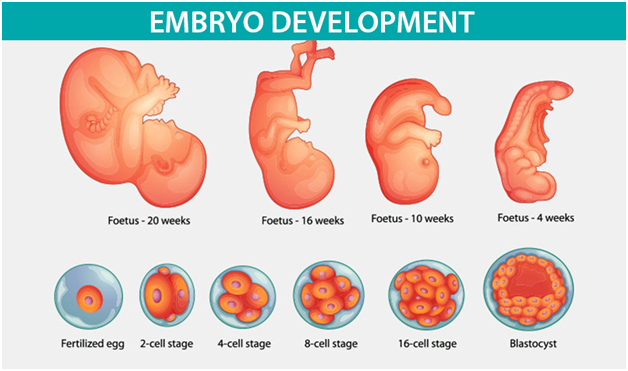Embryo Development
An embryo is the early stage of development of a multicellular organism. In general, in organisms that reproduce sexually, embryonic development is the part of the life cycle that begins just after fertilization and continues through the formation of body structures, such as tissues and organs. Each embryo starts development as a zygote, a single cell resulting from the fusion of gametes (i.e. the process of fertilization which is the fusion of a female egg cell and a male sperm cell).
In the first stages of embryonic development, a single-celled zygote undergoes many rapid cell divisions, called cleavage, to form a blastula, which looks similar to a ball of cells. Next, the cells in a blastula-stage embryo start rearranging themselves into layers in a process called gastrulation.

These layers will each give rise to different parts of the developing multicellular organism, such as the nervous system, connective tissue, and organs. A newly developing human is typically referred to as an embryo until the ninth week after conception, when it is then referred to as a fetus. In other multicellular organisms, the word “embryo” can be used more broadly to any early developmental or life cycle stage prior to birth or hatching.
Fertilization
Fertilization is the union of the female gamete (egg) and the male gamete (spermatozoa). Whether it occurs naturally inside the female reproductive system or with the assistance of reproductive technologies outside of the human body, the product is a structure called a zygote. When a woman is ovulating she releases one egg into her Fallopian tubes (or more in the case of fraternal twins). During this time, a woman’s cervical mucus will thin, in preparation for sperm to pass through more effectively. Following spermatozoa ejaculation inside the vagina, special secretions help them to swim through the cervix towards the uterine tube where fertilization takes place within 24-72h. The fertilized egg or zygote then begins to move toward the uterus, as the cells divide into the next stage, a blastocyst.
Blastocyst Development
Soon after fertilization, the embryo is created from a small group of cells that are constantly dividing inside of a complex structure called the blastocyst. It is formed by two groups of cells, inner and outer cells, and fluids. The blastocyst stays inside a protective cover during maturation called zona pellucida, which could be described as an egg shell. The outer cells are located right below this cover, which will create the future placenta and surrounding tissues to support fetal development in the uterus. The inner cells of the blastocyst will become the different tissues and organs of the human body, such as bones, muscles, skin, liver, and heart.
The cells within the blastocyst grow fast, they go through many changes and convert into more specialized cells, making the structure very tight. In humans, these changes happen during the first few days of development, before the implantation in the uterus. At this stage, the zona pellucida (similar to an egg shell) breaks and releases the blastocyst. It moves through the Fallopian tubes towards the uterus and implants around day ten.
Blastocyst Implantation
When the blastocyst reaches the uterus it implants in the endometrium, the mucus membrane which lines the uterus. The external cells of the blastocyst and the uterine inner lining, together, will create the future placenta. The placenta is a structure that transfers nutrients to the baby and removes his/her wastes.
Embryo Development
As the blastocyst reaches the final steps in the implantation process into the inner lining of the uterus, it evolves into a structure called an embryo. This is the time when internal organs and external structures develop. The mouth, lower jaw, throat are emerging, while the blood circulation system starts its evolution and a heart tube is created. The ears arise and arms, legs, fingers, toes, and eyes are being shaped. The brain and the spinal cord are already formed, while the digestive tract and sensory organs start their development. The first bones are replacing the cartilage. After ten-twelve weeks of pregnancy, the embryo moves into the final stage of development, a fetus.
Fetal Development
By the twelfth week of fertilization the embryo moves into the final stage of development called the fetal stage. By now, the fetus has formed all of the organs and structures necessary for a baby, but those organs still need to grow and develop. At three months of pregnancy, the upper and lower extremities of the fetus are completely developed. Ears and teeth are formed and the reproductive organs have evolved. At the end of this month, the fetus has completed the expansion of most of the circulatory and urinary systems and its length is about 5 inches. At six months, the fetus can respond to sounds and is around 12 inches long. The fetus continues to develop and grow changing position and responding to sounds, and stimuli. The length of the little body can reach 14 inches. The fetus becomes a baby at month eight. The brain is evolving quickly so the baby can see and hear, although the respiratory system requires maturation. The baby can weigh approximately 5 pounds. Close to the end of the pregnancy at month 9, the baby responds to stimuli, can move the whole body but space around the new human being is becoming too tight. If the baby had not changed his/her position inside the uterus, this is the right time to drop down into the pelvis towards the birth canal to face the world.
